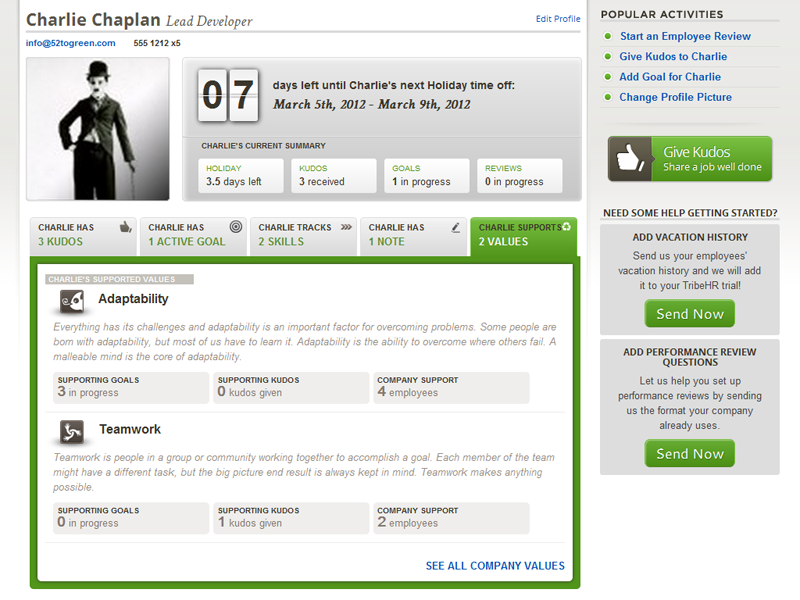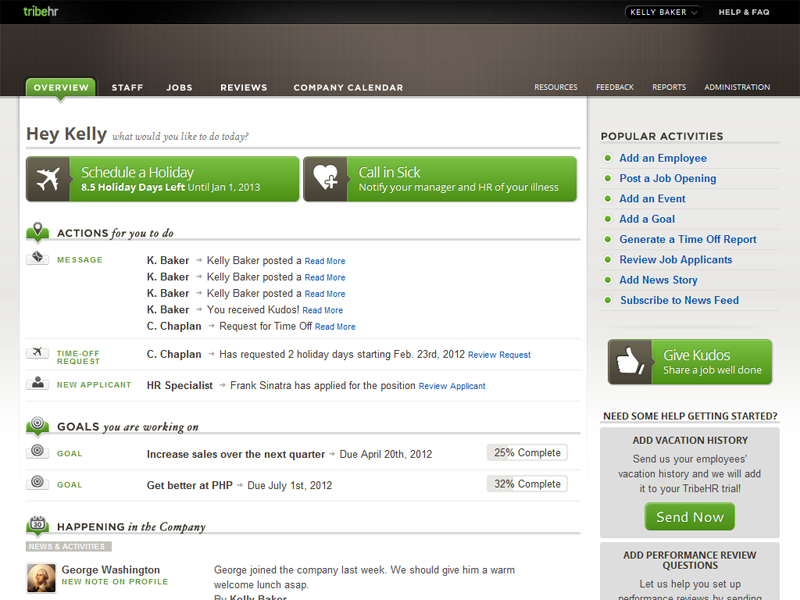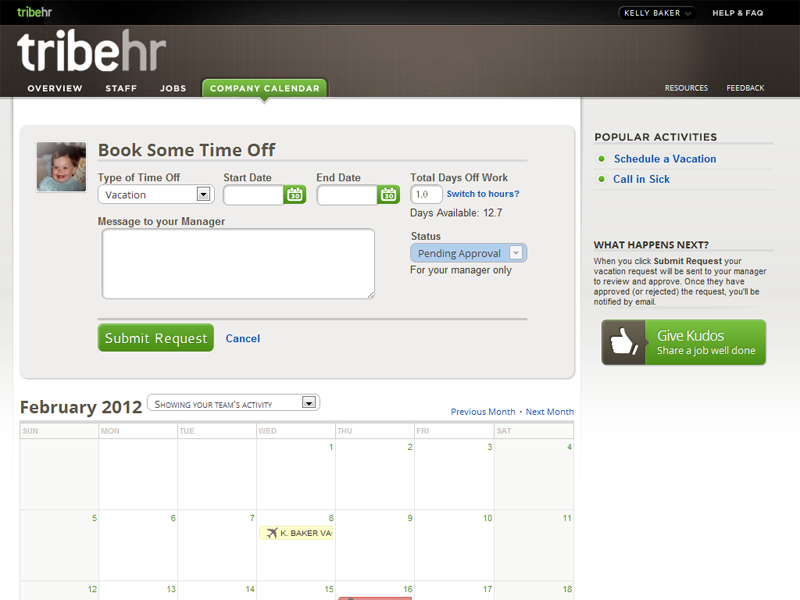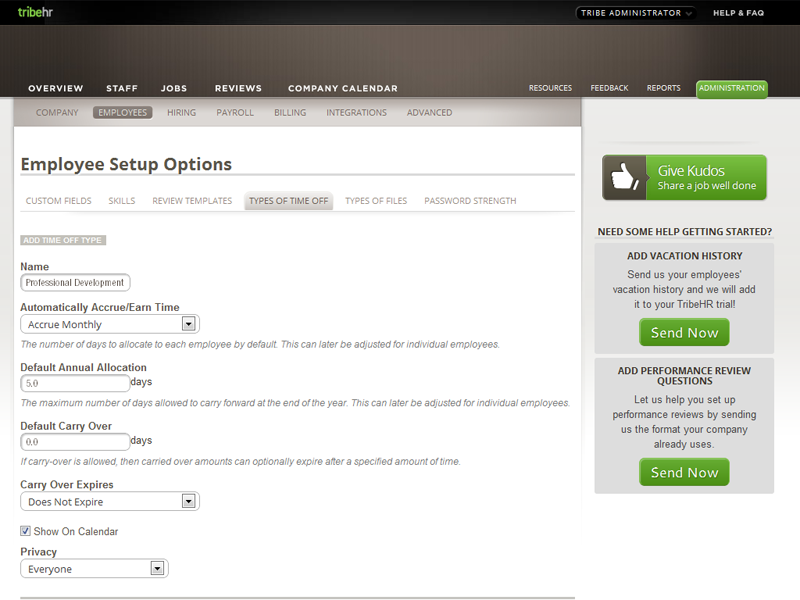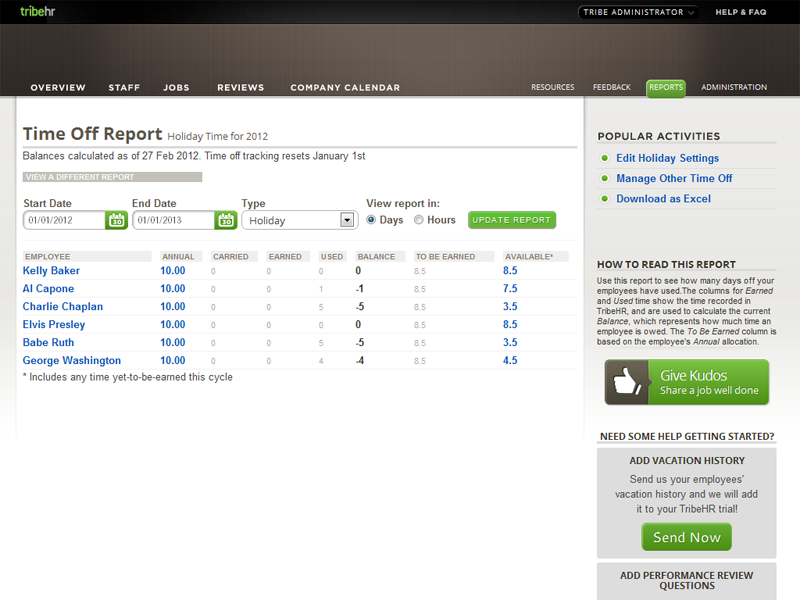Workforce Management
TribeHR Revolutionizes HR Software With Social

Editor’s Note: TribeHR was acquired by Netsuite, Inc. in 2013. For the latest changes to TribeHR platform be sure to check out their updated product profile.
Managing hundreds of employees is difficult enough without having an HR solution that isn’t intuitive or particularly useful, and yet that’s what thousands of businesses have to deal with every day. What if there was an HR software that not only made it easier on HR managers, but also made things easier for employees to look up their own information? That’s where TribeHR comes in. We talked to Joseph Fung, CEO and co-founder of TribeHR, about how the company got its start, the sorts of trends he sees in HR management, and what the next big thing for HR software in the future.
How was TribeHR founded and what was the impetus for doing so?

WEBSITE: www.TribeHR.com
LOCATION: Waterloo, ON; Boston, MA
CUSTOMERS: SMBs like bluebeetle, CloudSigma, Wave
What was the most difficult part about getting started for you guys?
The most difficult part, actually, was getting our HR advisory board actually on the same page in since the way that software is delivered has changed. Often, especially in this space, software is designed by talking to people who have domain expertise and asking them what they want. The reality, though, is that most people who are doing HR functions aren’t HR experts. They’re an average manager, a business owner with no HR training, or an employee who is engaging in an HR process, be it a performance review or booking a vacation. If you ask them what they need out of the HR process, it’s often very different. So what we’re actually trying to do is build software to do HR processes, but also help people who aren’t HR practitioners themselves. Getting everybody on the same page of that was the hardest part. Once we really got that ball rolling, though, it’s been an awesome ride ever since.
In terms of the disparities between what HR experts want and what people who actually perform HR functions want, what kind of differences did you tend to see?
If you ask an HR manager, for example, what they need to track vacation time, they’ll tell you they need a form where they can track the start of a vacation, the end of a vacation, how many days or hours it took, a signature line for who approved it, and the name of the employee who asked it; so a lot of the tools out there reflect that. If, however, you ask the employee what they need out of vacation tracking, they’ll tell you, “I want to know when will I have earned two weeks so I can take my time off,” or, “When will my colleagues be away on vacation because I know if I ask for vacation during those times it’s going to get rejected anyway.” They’re looking for things that the HR practitioner isn’t really thinking of, so trying to design software that actually meets their needs is really what’s given us our really unique advantage. Booking vacation was a very simple example, but if you think about going into performance reviews or doing salary reviews or trying to hire someone, the same challenges arise.
What was your approach for ensuring that you not only delivered a product that met all the needs of an HR manager, but also employees? What’s one of the main things that makes TribeHR different from other HR solutions?
When we founded the company, we created an advisory board of HR experts; but when we actually started building our team and hiring employees, we started with software and user experience designers. We actually started building our software from an end-user design perspective first as opposed to an HR domain knowledge first. We’ve actually borrowed a lot of the stories and a lot of the ideas that you might expect to see from new mobile software companies or gaming companies and applying that to the way we design HR software. The fact that we pay attention to the user interface, the user experience, and that we put such a high priority on the end employee’s experience really changes the way we build our software.
I think another thing is that we built our application with the idea of social interaction into it right from day one. A lot of other HR tools out there, they’re kind of bolting on the social thing, whereas we really imagined it from day one. So if an employee or a manager logs into TribeHR, the first thing they’re actually seeing is a feed of activity that is happening in their company. Hey, someone got a promotion, someone’s accomplished a goal, someone was recognized for a job well done. When you have the opportunity to say thanks to someone for helping you out, you actually have the opportunity to recognize multiple people and have that show up on their next performance review automatically. So we really baked in social processes throughout the software right from day one.
Another thing that sets us apart is that because we could design our system on more modern architectures, we actually highlight data and leverage data in a very different way. So whereas traditionally HR software thinks about data in terms of, “Hey, you have 51% men in your company and 49% woman,” what we actually do is we can take a look at the way people are interacting, the way they’re performing, notch that back to where that candidate originally came from and identify things like whether it’s better for your company to hire referrals from social networks because they stick around twice as long; or perhaps most of your engineering team is coming from this specific candidate pool and that’s why they’re performing very well. So the way that we leverage data and help our customers manage is something that just hasn’t been done before.
Is there an ideal type of customer for TribeHR and what does that customer look like?
We typically work with companies that have fewer than 500 employees which is in and of itself a fairly large departure. Most HR platforms out there right now focus on 1000+ companies. So we typically deal with SMBs, from five to 500 employees. We typically don’t work quite as well with companies that have a business model designed on a lot of turnover or seasonal workers. As you can imagine, that applies to a lot of SMBs. What it really comes down to, if you’ve got a company where you fundamentally care about your employees, retaining them is important and you want to help them perform more, chances are you’re going to be a good candidate for TribeHR.
Where do you see HR management headed in the next five years? What kind of changes in the landscape do you anticipate?
The really big thing is going to be shift to data-driven decision making. So much of HR historically has been based on gut reactions. A great example would be HR and the finance group will tell the management team, “Hey, you know, we have 2% available for salary increases across the board. Tell me how you’d like to divvy it up on your team.” And a manager hems and haws and kind of makes a guess and sketches it out. It’s not really based on as much data so much as their own gut reaction. Unfortunately, a lot of HR processes have historically been managed that way.
What you’re going to see over the next five years is just an increased reliance on the data. And we can already see it. Managers identifying how individuals are contributing to the team, contributing to goals, being recognized by colleagues, and being able to make real management decisions based primarily on data. For us, it fits perfectly well into our plan because that’s a lot of what we’re doing. Normally, in any other industry, that kind of data-driven shift was typically offered first to enterprises and only eventually trickled down to SMBs. We’re in the fortunate position of kind of really leading the charge and letting SMBs take advantage of these tools first.
What do you see as the major challenges in HR that companies face – or even that your customers face – and how can businesses overcome those challenges?
I think the challenge that comes along with that is that along with that shift in data-driven decision making, that means you’re going to see a shift in tools. A lot of traditional HR practices and more experienced HR managers will be using a lot of their own either industry-provided tools or home-brewed tools. On the small business side of things it’s often a lot of Excel spreadsheets and forms. But as new technologies are available, the one risk there is that the buying decision for those tools and technologies might not fit in the HR groove. Having individual managers, IT groups, perhaps even finance groups, implementing HR tools and making sure that the HR department, your HR manager, or even just whoever’s responsible for HR in your organization being involved in that decisions is going to be a key element. I think the best way to help overcome this challenge is to make sure that whoever’s responsible for HR is being proactive and identifying those tools, as opposed to waiting for someone else in the organization to just implement something.
Who do you think are the most innovative or interesting people or companies in the industry right now and why?
The first one I’d suggest is China Gorman. She was the former COO of SHRM – the Society for Human Resource Management. Not only is she a massive advocate for all of the fascinating changes going on, but she fundamentally understands that you have to look at the data to make good HR decisions. And on her blog she’ll share a data point every Tuesday that really gives you the opportunity to reinvestigate some of your assumptions around HR. And she’s doing a great job at kind of coaching the industry into using data to make their decisions.
On the flip side, I’d actually like to highlight Ali Asaria who’s the CEO and founder of Well.ca. Not at all in the HR space–they’re actually in the e-commerce space. They’ve done an incredible job of just rethinking how people use their mobile devices when they interact. For us, we give a lot of thought to how employees and managers interact with our software. Ali’s done a fantastic job of really breaking new ground. Their mobile app is a fantastic experience, and they’ve even broken the mold in thinking about how online shopping doesn’t have to be done from your computer. For example, if you’re waiting for the bus or subway, you could see a massive poster that looks like a store shelf, and from your phone actually do your shopping right there and have it shipped to your home. So really thinking outside of the box about new ways that people and their mobile devices can take care of traditional tasks. It’s a lot of how we look at problems, and Ali’s done a great job of really living and breathing that with his own company.
What makes you the most excited about what TribeHR is doing?
We’re uncovering data and findings that have previously never been available before. If you take a look anywhere at salary surveys or raise surveys, they’re almost all dominated by very large companies. And you’ll hear comments about things like the average employee gets a 2% raise or things like that, and those surveys, because they’re run by industry-wide associations – the HRPA in Canada, Sherman Estates – they’re still heavily weighted by larger business. We just released a pay index earlier in November that identified some really interesting trends in the SMB space. We identified that, against what’s commonly believe, women actually get more frequent raises than men. Unfortunately, men actually get larger raises. So there’s still very much a raise disparity there and a raise gap, and we’re at the stage now where we’re able to use the data that we’re collecting, do really interesting anonymized analyses behind information that previously has never been available. And that’s going to be fantastic in helping SMBs make better decisions and really grow their businesses.
Was that one of the more surprising statistics that you found? Or was there something else that surprised you even more, like when you started looking at the data from your customers?
The disparity there was really fascinating…women getting more raises but smaller, but what was really interesting out of it was that the disparity gets worse the bigger the raise. So, for example, although it was a slight leaning towards men getting larger raises across the whole sample set, when we took a look at raises that were 5% or more – so a raise that’s almost identifiable as a performance-based raise as opposed to cost of living – it was almost a two to one ratio in terms of raises being given to men. And in the very small subset of those people who got large raises – like 25% or more, like a severe promotion – it was almost a four to one ratio of men to woman getting those raises. So what we saw was, across the board, predominantly – yes, women were getting significantly more frequent raises but they were smaller. And so the magnitude of the difference and the fact that it was bigger – the bigger difference, the bigger the raise – was a very big surprise.
The next the pay raise index update will be coming in January, and we’ll be taking a look at a couple of new facets, not just by gender, but also by reporting structure on some of the raises. So that’s going to be an ongoing project for us. We also have an interesting report that’s coming out in December that’s just taking a look at some of the shift in HR over the last couple of decades. So, I talk a lot about using data to make decisions in one’s own business, but we have a lot of fun taking a look at just the industry and the trends as a whole as well.
Do the customers have easy access to the information like this that’s just about their own company or do they also have access to the overall view of other users as well?
We’ll provide industry-wide analyses like that so that it allows people to benchmark and compare, but, yes, we make it very easy for people to take a look at data within their own organization. So a great example is we can take a look and help you as an organization to see that your sales department is being recognized for sticking to your company values way more than, say, your support group is; or there’s this individual in your organization that you never speak to as a business owner, but they are constantly being congratulated by their peers for doing a job well done. This idea of using the data to make decisions means that you never get stuck in a situation where that quiet over performer is ignored or the person who’s under performing but happens to be really loud is getting recognized. So it lets you as a manager just have a much higher degree of confidence in the decisions that you’re making.


